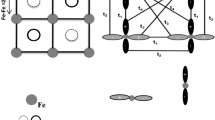Abstract
The two-orbital Hubbard model is used to obtain formulas for the fermion excitation spectrum in the energy bands hybridized by the Anderson interaction. An analysis of lower part of the energy spectrum leads to a formula for the superconducting transition temperature T c associated with the pairing of quasiparticles in one of the correlated bands. The dependence of T c on pressure is analyzed, and the individual influence of carrier density enhancement and interaction strength is obtained as a function of oxygen concentration. The experimental discrimination made by Honma et al. [Solid State Commun 98, 395 (1996)] in Y0.9Ca0.1Ba2Cu3O7−δ by separating out the contributions due to carrier density and pairing strength can be reproduced quantitatively, and perhaps with further refinement, so can the carrier concentration. Although the prediction of the absolute value of the transition temperature using the present model is not accurate, it is clear that it furnishes a reasonably accurate description of the change in transition temperature with pressure. The component contributions due to the change in carrier concentration and due to the change in interaction strength as a function of oxygen concentration are also in reasonable agreement with the experimental results.
Similar content being viewed by others
References
J. S. Schilling and S. Klotz, Physical Properties of High Temperature Superconductors, Vol. III, ed. by D. M. Ginsberg, World Scientific, Singapore (1992).
H. Takahashi and N. Mori, Studies of High Temperature Superconductors, Vol. 16, ed. by Anant Narlikar, Nova Science Publishers (1996).
M. W. Shafer, T. Penny, B. L. Olson, R. L. Greene, and R. H. Koch, Phys. Rev. B 39, 2914 (1988).
Y. Kubo, Y. Shimakawa, T. Monako, and H. Igarashi, Phys. Rev. B 43, 7875 (1991).
Y. Iye, J. Phys. Chem. Solids 53, 1561 (1992).
T. Honma, K. Yamaya, N. Mori, and M. Tanimoto, Solid State Commun. 98, 395 (1996).
A. A. Kosov and V. E. Shilov, Fiz. Nizk. Temp. 22, 1032 (1996) [Low Temp. Phys. 22, 787 (1996)].
J. Zielinski, M. Matlak, and P. Entel, Phys. Lett. A 136, 441 (1989).
A. A. Kosov, Fiz. Nizk. Temp. 24(3), (1998) [Low Temp. Phys. 24, (3) (1998)].
Yu. A. Izyumov, M. I. Katsnel’son, and Yu. N. Skryabin, Magnetism of Collectivized Electrons, (in Russian), Nauka, Moscow (1994).
P. B. Zyubin, V. A. Ivanov, and E. A. Ugolkova, Teor. Mat. Fiz. 101, 304 (1994).
R. O. Zaitsev and V. A. Ivanov, Fiz. Tverd. Tela 29, y2554 (1987) [Sov. Phys. Solid State 29, 1475 (1987)].
F. Marsiglo and J. E. Hirsh, Phys. Rev. B 41, 6435 (1990).
Author information
Authors and Affiliations
Additional information
Zh. Éksp. Teor. Fiz. 115, 80–88 (January 1999)
Published in English in the original Russian journal. Reproduced here with stylistic changes by the Translation Editor.
Rights and permissions
About this article
Cite this article
Kosov, A.A., Boughton, R.I. Analysis of the effect of oxygen doping and pressure on superconducting transition temperature in metal oxides. J. Exp. Theor. Phys. 88, 46–50 (1999). https://doi.org/10.1134/1.558762
Received:
Issue Date:
DOI: https://doi.org/10.1134/1.558762




